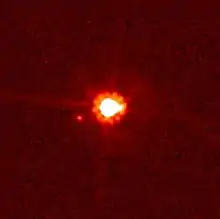ဒီဆနိုးမီးယား (ဂြိုဟ်ရံလ)
ဒီဆနိုးမီးယား (အင်္ဂလိပ်: Dysnomia) (ဂရိ: Δυσνομία) သည် ဂြိုဟ်ပု အဲရစ် (နေအဖွဲ့အစည်း၌ အကြီးဆုံး ဂြိုဟ်ပုဟု သိရှိထား)၏ ဂြိုဟ်ရံလဖြစ်ပြီး ၂၀၀၅ ခုနှစ်တွင် Michael E. Brown က ရှာဖွေတွေ့ရှိခဲ့သည်။[5] အချင်းအားဖြင့် ၇၀၀ ကီလိုမီတာဝန်းကျင်ရှိပြီး အဲရစ်အား ၁၅ ရက်ခန့်လျင် တစ်ပတ်နှုန်းဖြင့် လှည့်ပတ်လျက်ရှိသည်။[2]
 Dysnomia, to the left, and Eris, center (Hubble Space Telescope) | |
| ရှာဖွေတွေ့ရှိခြင်း | |
|---|---|
| ရှာဖွေတွေ့ရှိခဲ့သူ | Michael E. Brown, M. A. van Dam, A. H. Bouchez, D. Le Mignant, R. D. Campbell, J. C. Y. Chin, A. Conrad, S. K. Hartman, E. M. Johansson, R. E. Lafon, D. L. Rabinowitz, P. J. Stomski Jr., D. M. Summers, C. A. Trujillo, and P. L. Wizinowich[1] |
| ရှာဖွေတွေ့ရှိသည့် ရက်စွဲ | September 10, 2005[1] |
| အသံထွက် | /dɪsˈnoʊmiə/ or /daɪsˈnoʊmiə/[lower-alpha 1] |
အခြားအမည်များ | S/2005 (2003 UB313) 1 |
| ပါဝင်အရာဝတ္ထုများ | Dysnomian |
| ပတ်လမ်း ဂုဏ်အင်များ[2] | |
ဆီမီး မေဂျာ ဝင်ရိုး | 37350±140 km |
| ပတ်လမ်း ဗဟိုကျမှု | < 0.013 |
ပတ်လမ်း ကာလ | 15.774±0.002 d |
ပျမ်းမျှ ပတ်နှုန်း | 0.172 km/s |
| ပတ်လမ်း တိမ်းစောင်းမှု | 142°±3° |
| ဂြိုဟ်ရံလများ | အဲရစ် |
| ရုပ်ပိုင်းဆိုင်ရာ ဂုဏ်အင်များ | |
အီကွေတာ အချင်းဝက် | 350±60 km[3] |
| Albedo | 0.04+0.02 −0.01[3] |
မြင်သာသော အရွယ်အစား | ~25.4[lower-alpha 2] |
ပကတိ အရွယ်အစား (H) | ~5.6[lower-alpha 2][4][3] |
မှတ်စု
- dis-NOH-mee-ə or dys-NOH-mee-ə. The former is the normal mythological pronunciation, the latter is used by Brown.
- Dysnomia's brightness is 1/500 of Eris in the visible band. With H = −1.19 for Eris, this gives H ≈ 5.6 for Dysnomia.
ကိုးကား
- "Satellites of the Largest Kuiper Belt Objects" (2006). Astrophysical Journal Letters 639 (1): L43. doi:. Bibcode: 2006ApJ...639L..43B. Retrieved on 2011-10-19.
- "The Mass of Dwarf Planet Eris" (2007). Science 316 (5831). doi:. PMID 17569855. Bibcode: 2007Sci...316.1585B.
- Brown၊ Michael E.; Butler၊ Bryan J. (2018)။ "Medium-sized satellites of large Kuiper belt objects"။ arXiv:1801.07221။
- Brown၊ M. E. (14 June 2007)။ Dysnomia, the moon of Eris။ Caltech။ 2011-07-03 တွင် ပြန်စစ်ပြီး။
- Green, D. W. E. (13 September 2006). "(134340) Pluto, (136199) Eris, and (136199) Eris I (Dysnomia)". IAU Circular 8747. Retrieved on 12 January 2012.
This article is issued from Wikipedia. The text is licensed under Creative Commons - Attribution - Sharealike. Additional terms may apply for the media files.

